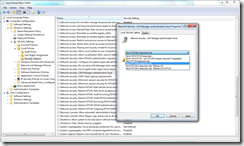Fix for Ping request could not find host "FQDN of server" ErrorI can ping by their IP address but not by their name
ping 192.168.1.3 --works
ping familypc --doesn't work
Ping request could not find host ___ Please check the name and try again
Solution
Need to setup WINS server or service on one of the computer. Or if
you're using one of those gateway/router for internet sharing, you can
set your wins server as that since it has capabilities of DHCP
Best solution
Windows firewall was blocking port 137. After unblocking it worked fine.
At command prompt
ping myserver.mydomain.local
I get back the message “Ping request could not find host
myserver.mydomain.local. Please check the name and try again.”
An nslookup works fine, so I know the SBS server is there and is responding to DNS requests.
In fact, I can “ping myserver” without problems. But for some reason, pinging the fully-qualified internal name doesn’t work.
Sometimes, I can just type “ipconfig /flushdns” to clear this up.
Today that didn’t work. However once I actually stopped and started the
DNS cache, ping started working
net stop DNScache
net start DNScache
---------
Windows XP Home SP3. “PING name” does not find the host, and “PING
ip-address” works fine. Also, “NSLOOKUP name” and also “NSLOOKUP name
dns-server-ip-address” both work fine; that is NSLOOKUP works using it’s
own default, and also using any valid DNS server I specify. But, PING
and various other software like browsers, anti-virus, and pretty much
any other name-dependent software will not function.
--------
Can still ping both ways by IP addr but not by computer name and hence
Network Neighborhood only shows the source PC name, and can not see the
other shared folders
---------------
Are NSLOOKUPs resolving the names correctly? Does it help if you stop then start the “DNS Client” service (not just “DNSCache”)?
Despite multiple cache clearings, browsers can't find it either (it's an
internal website). I am suspecting this is why. I am not sure how,
after several /flushdns and /registerdns, if nslookup finds it right
off, why can't anything else..?
--------------------------
nslookup does not use the same references as ping
Ping will directly query the DNS server defined in ipconfig
nslookup will quiery the DNS server, on the AD domain controller your security was authenticated on.
Ping simply asks DNS give me the ip so I can ping it.
Their
is no record in DNS for a myhost PC. But the code within the AD DNS
schema has a refernce for a nslookup so you are returned the address of
your authentication server..
If you invoke nslookup and put a x
in front of it, you will get a > prompt. Type in a question mark at
the prompt and you can see the switches to get the info you need with
nslookup.
---------------------------
Win 2k3 'Round Robin' setting
I didn't set this box up - looking at the DNS settings, i see it's set for round robin.
configured on the workstations? To clarify, on your workstations, do you
have the primary DNS server as the ADC and a secondary DNS server ip
that points to a non-Active Directory DNS server?
Answer
On Windows 2000
and later, if a request to your primary DNS server times out, it
switches to the secondary DNS server and stays with it for a period of
time. However, nslookup always connects to the primary.
Take a look at this article and be sure to read the part about caching negative responses.
Windows contains a client-side Domain Name System (DNS)
cache. The client-side DNS caching feature may generate a false impression that
DNS "round robin" is not occurring from the DNS server to the Windows client
computer. When you use the ping command to search for the same A-record domain name, the client
may use the same IP address. This behavior is different from Microsoft
operating systems earlier than Windows 2000. These operating systems do not
include the client-side DNS caching feature. This article describes how to
disable DNS caching.
Note This article refers to the client portion of DNS. Do not use this
information for making changes to DNS servers.
To stop DNS caching, run either of the following commands:
- net stop dnscache
-or-
- sc servername stop dnscache
To disable the DNS cache permanently in Windows, use the
Service Controller tool or the Services tool to set the DNS Client service
startup type to Disabled. Note that the name of the Windows DNS Client service
may also appear as "Dnscache."
Note The overall performance of the client computer decreases and the
network traffic for DNS queries increases if the DNS resolver cache is
deactivated.
The DNS Client service optimizes the performance of DNS
name resolution by storing previously resolved names in memory. If the DNS
Client service is turned off, the computer can still resolve DNS names by using
the network's DNS servers.
When the Windows resolver receives a
positive or negative response to a query, it adds that positive or negative
response to its cache, and as a result, creates a DNS resource record. The
resolver always checks the cache before querying any DNS server. If a DNS
resource record is in the cache, the resolver uses the record from the cache
instead of querying a server. This behavior expedites queries and decreases
network traffic for DNS queries.
You can use the Ipconfig tool to
view and to flush the DNS resolver cache. To view the DNS resolver cache, type
ipconfig /displaydns at a command prompt. Ipconfig
displays the contents of the DNS resolver cache, including the DNS resource
records that are preloaded from the Hosts file and any recently queried names
that were resolved by the system. After a certain time period, the resolver
discards the record from the cache. The time period is specified in the Time to
Live (TTL) associated with the DNS resource record. You can also flush the
cache manually. After you flush the cache, the computer must query DNS servers
again for any DNS resource records previously resolved by the computer. To
delete the entries in the DNS resolver cache, type ipconfig
/flushdns at a command prompt.
[...]
Subnet Prioritization
The Windows XP DNS resolver also uses Subnet Prioritization. If
the resolver receives multiple IP address mappings (A resource records) from a
DNS server, and some of the records have IP addresses from networks to which
the computer is directly connected, the resolver places those resource records
first. This behavior reduces network traffic across subnets by forcing
computers to connect to network resources that are closer to them.
Although subnet prioritization does reduce network traffic across
subnets, in some cases you may prefer to have the round robin feature work as
described in RFC 1794. If so, you can disable the Subnet Prioritization feature
on your clients by adding the
PrioritizeRecordData
registry entry with a value of 0 (REG_DWORD data type) in the
following registry key:
For additional information, click the following article numbers to view the
articles in the Microsoft Knowledge Base:
HKEY_LOCAL_MACHINE\SYSTEM\CurrentControlSet\Services\DnsCache\Parameters
297510
How to Modify Time to Live on Domain Name System Records
286834
The DNS Client Service Does Not Revert to Using the First Server
For more information, see the Microsoft Windows XP Professional
Resource Kit Documentation, chapter "DNS Caching, Network Prioritization, and
Security."
Reply
We have no secondary internal DNS, and had round-robin set on the DNS
server: i already turned that off. We are serving 2nd/tertiary DNS
servers via DHCP to client workstations. I've turned off neg caching
for all stations, serving a .reg via GPO. So far, on my own machine, i
have seen no issues. Since this has been sporadic, it'll likely be a
few days before i know it's gone for good.
I'm hoping this will also clear up the weird sudden-loss-of-shares and exchange issues
...
So: it is NOT resolving the CNAME correctly, but when asked about the
machine itself, data, it resolves to the correct IP, and then the CNAME
resolves "thru" the machine name to the target IP.
I incremented
the serial the last time i made DNS changes. I made the above-suggested
zero-neg-cache registry change. I have rebooted the machine and
ensured all settings are current and policies are being applied.
DNS resolve problem with ping but not nslookup
windows XP SP3
my PC was not able to resolve DNS with most internet software
I tried pinging google and it also fails.
ping www.google.com
Ping request could not find host www.google.com. Please check the name and try again.
But nslookup can still work
*** Can't find server name for address 192.168.0.1: Non-existent domain
*** Default servers are not available
Server: UnKnown
Address: 192.168.0.1
Non-authoritative answer:
Name: www.l.google.com
Addresses: 209.85.165.103, 209.85.165.104, 209.85.165.147, 209.85.165.99
Aliases: www.google.com
------------------
Ping isn't going to work with many of the external host sites, so this is
normal. If you can do an nslookup on a site, then dns is resolving
correctly.
------------------
tenroc2o0o:
I've had the exact same issue on two computers and until I read this
form it didn't occur to me it might have to do with SP3. I had just
deployed SP2 & SP3 via group policy to over 40 PCs at my clients
location while joining all of their computers to the new active
directory network.
Basically, unless I use nslookup, DNS doesn't work. This includes
Firefox, Internet Explorer, as well as internal active directory lookups
to authenticate usernames and passwords against the domain. Noone
could log on to the computer as a domain user - had to logon as local
admin to work on it.
This means I could, say, "nslookup myserver.mydomain.local", get the IP, and then manually ping the IP and get a reply.
However, if I said "ping myserver.mydomain.local" it would say "Ping
request could not find host myserver.mydomain.local. Please check the
name and try again."
To me, basically this means nslookup can query because it simply opens a
winsock connection on the DNS port and gets a query itself, whereas
ping, IE, Firefox, and Windows itself for active directory domain
authentication all cannot since they use the DNS Client service.
I had this same problem on now two computers. The first one, which I
worked on earlier this week, I ended up formatting the computer to fix.
I tried specifying a static IP & DNS instead of using DHCP.
I tried uninstalling/reinstalling the network adapter.
I checked the Winsock using LSPFix to make sure there weren't any files missing or malware.
I checked hijackthis log for other malware - all clean.
I tried resetting all of the registry entries for the TCP/IP stack using
netsh int ip reset c:\resetlog.txt
SP3 reinstallation fixed all of the DNS query issues.
It's worth noting that even though DNS didn't work, WINS and NetBIOS
still did so I could still connect to our server via \\myservername (or
by IP of course). (whereas \\myservername.mydomainname.local did not
because that's a DNS entry)
I just connected to my server & ran the SP3 update again and it fixed all of the DNS resolution problems.
----------------
Linux
I got the same problem with my two new virtual redhat and suse. It was
the directory LDAP client which was the problem. Now both servers are
running correctly.
If using linux (redhat or suse):
look at nsswitch.conf & ldap.conf
1) put "bind_policy soft" in /etc/ldap.conf
2) nsswitch.conf must minimum have:
passwd: compat
group: compat
hosts: files dns
networks: files dns
services: files
protocols: files
rpc: files
ethers: files
netmasks: files
netgroup: files
publickey: files
bootparams: files
automount: files nis
aliases: files
3) reboot
4) check with: ping, nmap localhost.
5) now you can enable your ldap client again. (RH: authconfig ; suse: yast2 ldap). It will modify your nsswitch.conf
-------------------
pings and nslookup problems are not related to AD, rather they are based
on the client's network configuration and the client side resolver
service






















 LibreOffice
LibreOffice Firefox
Firefox